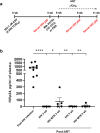Advancing our understanding of HIV co-infections and neurological disease using the humanized mouse
- PMID: 34134725
- PMCID: PMC8206883
- DOI: 10.1186/s12977-021-00559-z
Advancing our understanding of HIV co-infections and neurological disease using the humanized mouse
Abstract
Humanized mice have become an important workhorse model for HIV research. Advances that enabled development of a human immune system in immune deficient mouse strains have aided new basic research in HIV pathogenesis and immune dysfunction. The small animal features facilitate development of clinical interventions that are difficult to study in clinical cohorts, and avoid the high cost and regulatory burdens of using non-human primates. The model also overcomes the host restriction of HIV for human immune cells which limits discovery and translational research related to important co-infections of people living with HIV. In this review we emphasize recent advances in modeling bacterial and viral co-infections in the setting of HIV in humanized mice, especially neurological disease, and Mycobacterium tuberculosis and HIV co-infections. Applications of current and future co-infection models to address important clinical and research questions are further discussed.
Keywords: Co-infections; Hepatitis B virus; Hepatitis C virus; Human immunodeficiency virus; Humanized mouse; Mycobacterium tuberculosis; Neisseria gonorrhoeae; Small animal model.
Conflict of interest statement
The authors declare they have no competing interests.
Figures


References
-
- World Health Organization . WHO HIV/AIDS fact sheet. Geneva: World Health Organization; 2019.
-
- WHO . Global tuberculosis report. Geneva: World Health Organization; 2019. p. 2019.
Publication types
MeSH terms
Grants and funding
LinkOut - more resources
Full Text Sources
Medical

